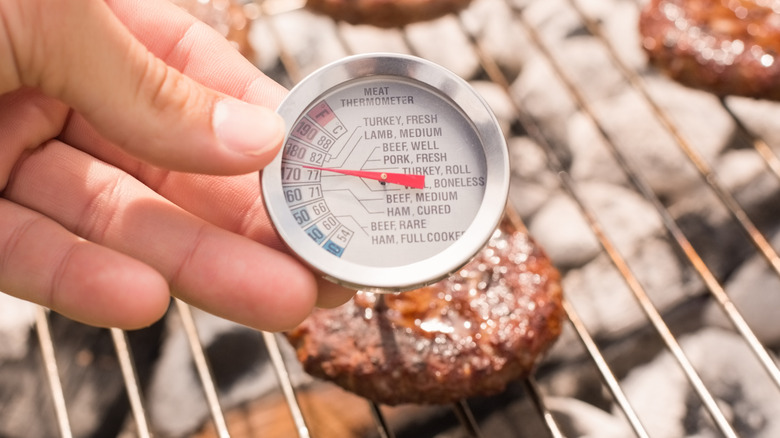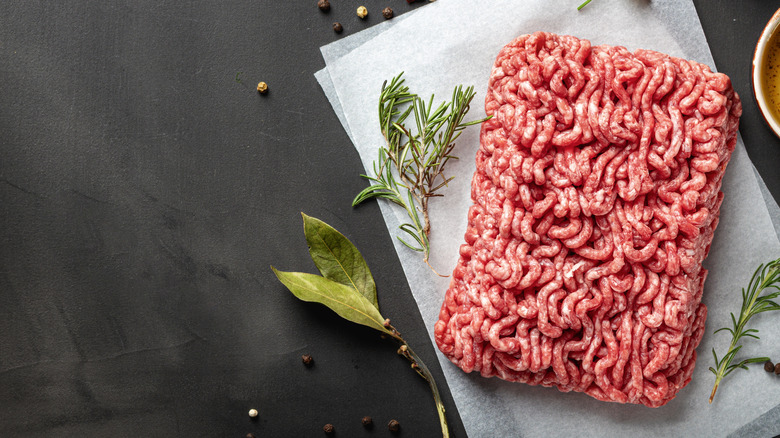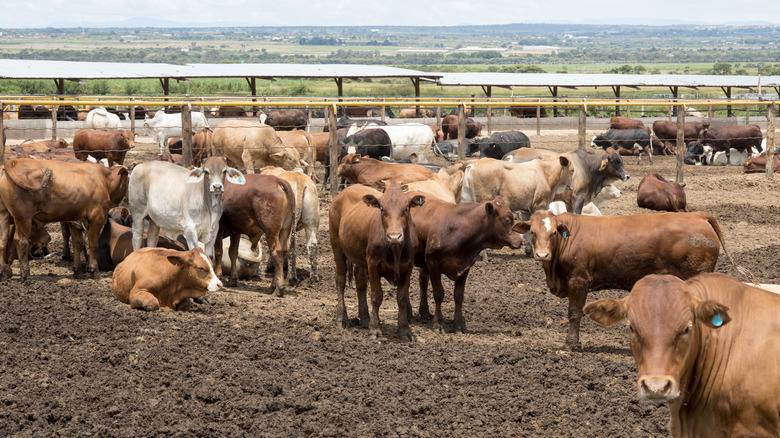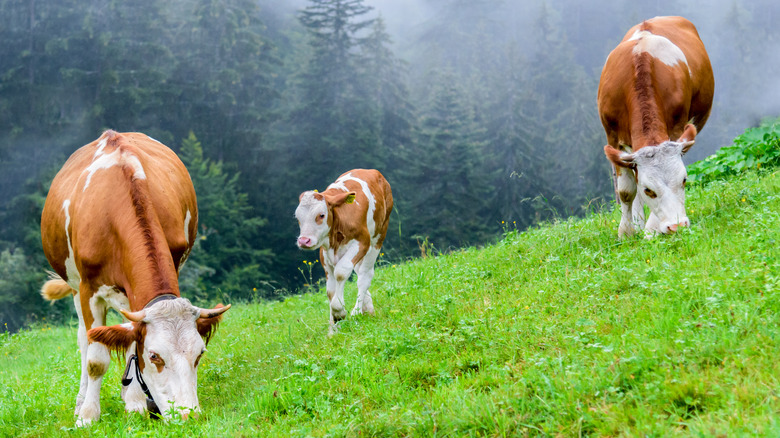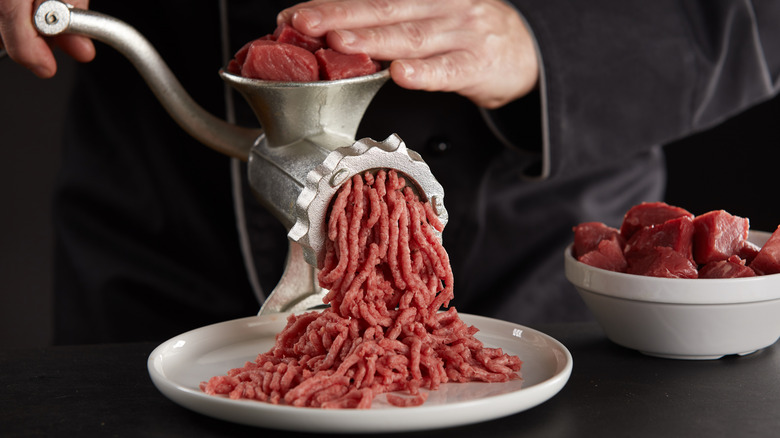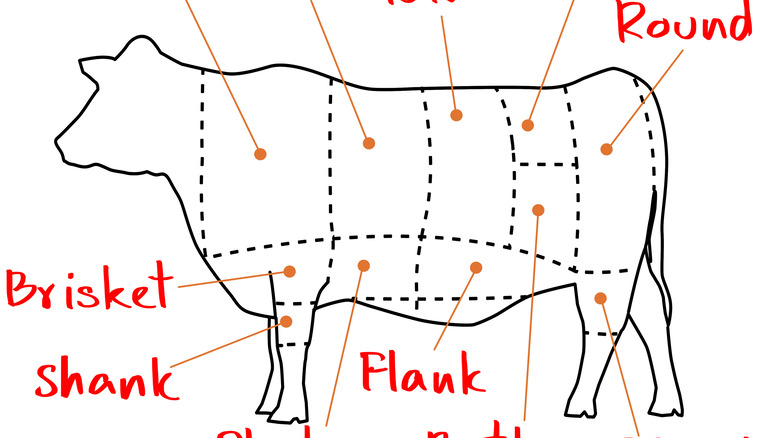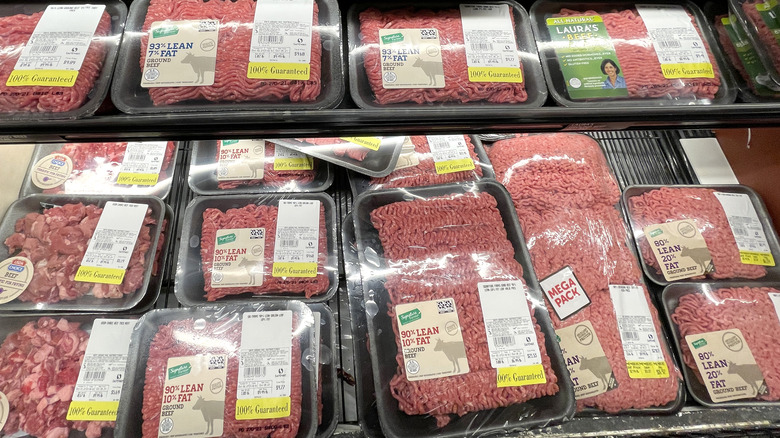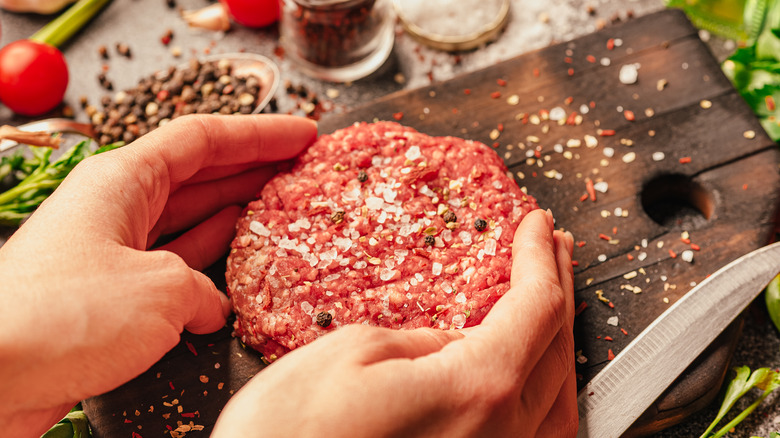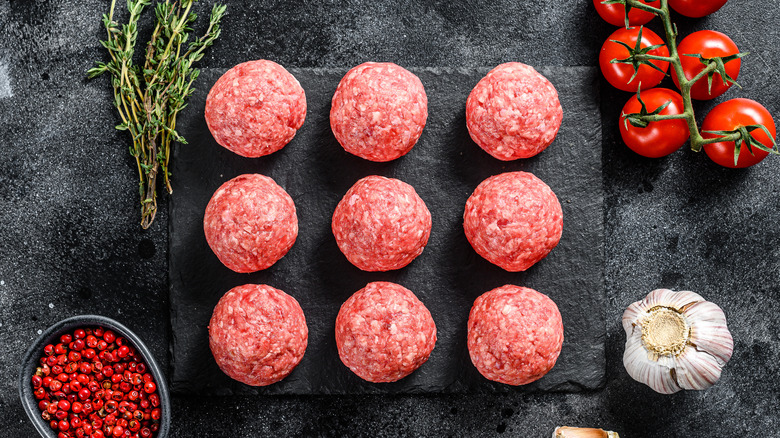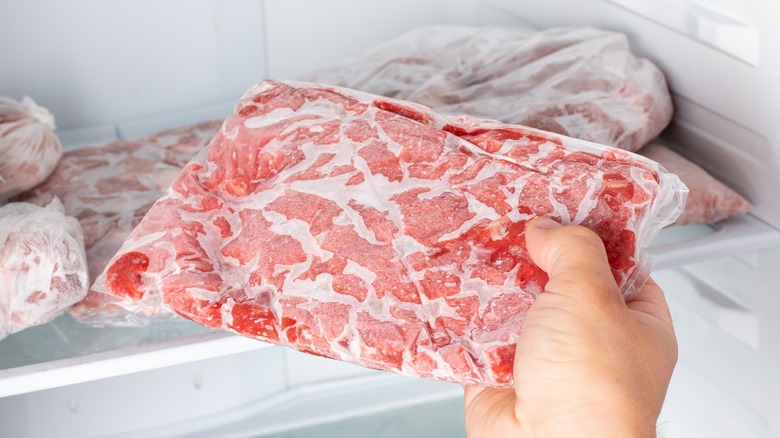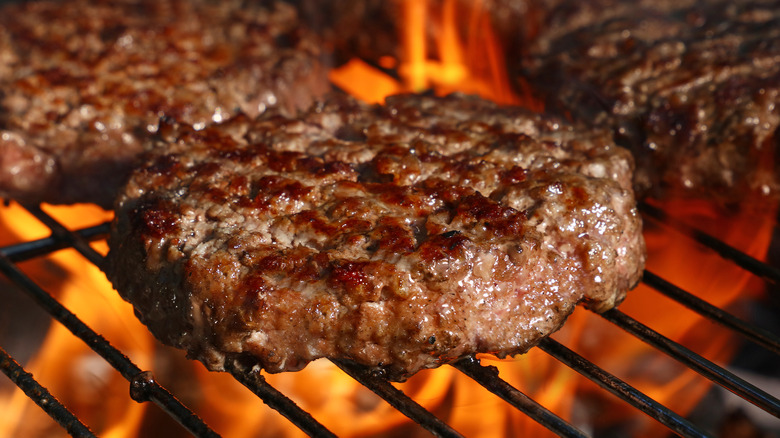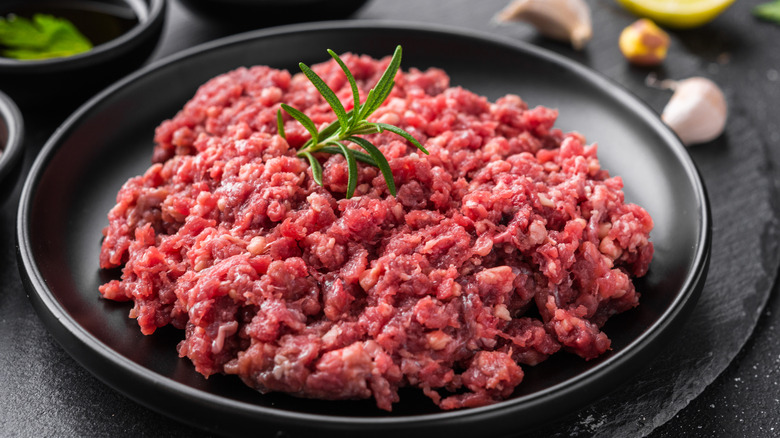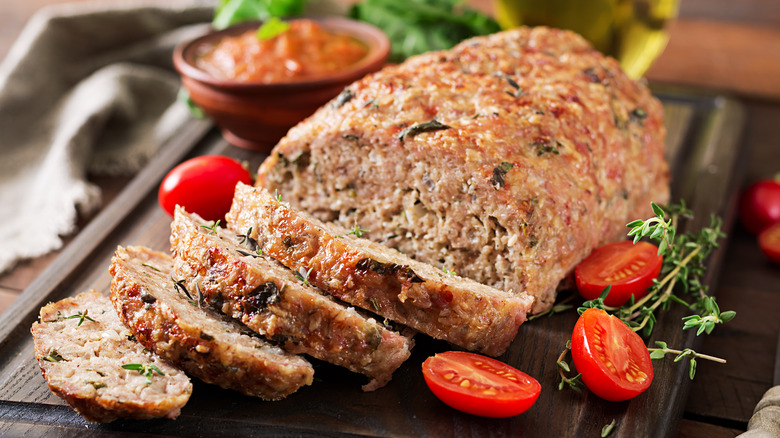What To Know Before Buying Ground Beef
Ground beef is one of the most versatile and cost effective cuts of meat out there. According to Iowa State University, in 2020 the U.S. consumed around 27 pounds of ground beef per capita, almost half of all beef consumption. Whether you are feeding a large family or making a casual dinner for two, there are some important things to keep in mind when you are buying ground beef. Gauging what type of ground beef is the healthiest, what fat percentage is best for a particular recipe, or what might be the most sustainable option available are all key factors. And if you have ever wondered about the difference between organic and conventional beef production or whether meat that is gray is safe to eat, look no further.
The next time you are craving a juicy burger, making a luscious Ragu Bolognese, whipping up comforting meatloaf, or prepping some spicy tacos, this guide will be invaluable in making the best versions of these that you've ever eaten.
Is ground beef safe?
All meat, when consumed undercooked, has the potential to be dangerous. Beef is often eaten rare, which presents a particular risk for ground beef. According to Consumer Reports, the meat of multiple cows may be combined together in one package of ground beef. In their 2015 study, samples from 300 different packages of ground beef — from conventionally processed to sustainably raised — were tested for a myriad of pathogens. Every sample came back positive for fecal bacteria which is responsible for E. Coli, and several of the conventionally produced samples came back showing evidence of antibiotic resistant superbugs.
Consumer Reports suggests that the culprit is factory farming, which represents 97% of all beef for sale. Thousands of cows are crowded together on unsanitary feedlots which makes them susceptible to diseases. Consumer Reports also explains that these cows are fed a diet rich in grains like corn and soy, something their digestive systems are not designed for. While this diet puts weight on quickly, making the animals more profitable, it can cause infections in their gut, necessitating that the cattle are given low doses of antibiotics. Once cattle reach the slaughterhouse, the high speed of processing can result in sanitation shortcuts, enabling bacteria from their digestive systems to spread into the meat.
The solution according to the U.S.Department of Agriculture (USDA) is to cook ground beef to a minimum internal temperature of 160 degrees. The best way to assess this is using a meat thermometer inserted into the thickest part of the meat.
Is ground beef healthy?
Beef in general, and ground beef in particular, tends to get a bad rap in terms of health. However, as per Livestrong, the discussion surrounding whether beef is good for you or bad for you is a nuanced one, influenced by a number of factors including your individual health profile. Ground beef can be a good source of protein and many minerals, including iron, potassium, and zinc, as well as B vitamins. Where ground beef runs into trouble is the high concentration of saturated fat it contains, something that is of particular concern for those who have cardiovascular disease or who are genetically predisposed toward developing it.
Livestrong explains, however, that this can be mitigated by purchasing ground beef with a higher percentage of protein to fat as well as opting for ground beef made with cuts that contain high percentages of marbled fat, such as Wagyu and Hanwoo beef. According to the Korean Journal for Food Science of Animal Resources, these types of beef, which originate from Japan and Korea, are raised in such a way that they contain higher levels of oleic acid, increasing their percentage of monounsaturated fatty acids. This makes their meat less likely to influence cholesterol levels giving them a significant advantage in terms of cardiovascular health.
Is eating ground beef bad for the environment?
Consuming beef does contribute to polluting the environment in several ways, however, abstaining from eating ground beef isn't necessarily the solution. According to the New York Times, raising any livestock causes deforestation as land is needed to grow feed, but cattle in particular represent the highest percentage of this. Additionally, the beef industry produces extremely high quantities of methane, one of the greenhouse gasses cited as directly related to climate change.
The New York Times further explains that because ground beef is a by-product of beef production as a whole, simply reducing ground beef consumption won't do anything to mitigate the influence beef production has on the environment. Humans would have to significantly reduce their consumption of all cuts of beef and dairy for this to have a meaningful effect. Switching to beef that has been grass fed from birth to slaughter might be a more sustainable choice in terms of reducing carbon footprint, but there is some debate as to how much better it is overall since the animals take longer to reach their full weight, giving them more time to emit methane. Ultimately moderation is key. As per Scientific American, if every American reduced their meat consumption by 25%, greenhouse gas emissions would fall by 1%. Incorporating just a few meatless meals per week is a great way of achieving that objective.
Is organic ground beef worth the cost?
As per Mic, the debate surrounding the benefit of purchasing organic meat is a hotly contested one. This is complicated by the fact that an organic certification is a luxury often reserved for larger farms who can afford to pay for it. Many smaller farms not certified as organic adhere to organic practices including using organic feed, no antibiotics, no growth hormones, and providing adequate space for the animals to roam freely outside. Mic also explains that many more farms may not use organic feed but opt not to use antibiotics or growth hormones, making them ineligible for organic certification but potentially healthier for consumers concerned with antibiotic resistant superbugs or hormone dependent cancers. And then there is the murky water of grass fed beef. This label can often be misleading as some grass fed beef may be fed organic feed part of the year and not actually consume grass from birth to slaughter.
Mic emphasizes that short of knowing an individual farmer, there's no guarantee of exactly what you are paying for when purchasing something labeled "organic" at the grocery store. If you are concerned about animal welfare or sustainability, seek out a local source for your ground beef or do some hunting for online resources where you can ask specific questions about how the animals are cared for and what environmentally protective measures are being taken.
Fresh ground is best
If you want to ensure you are getting the highest quality, safest ground beef, having it ground fresh by a butcher or grinding it at home is best. But first, you have to select the cut of beef you want to have ground and that can be a bit of a challenge. As a general rule of thumb, Cook's Illustrated suggests opting for either chuck or sirloin. While the chuck is higher in fat making it more suitable for a juicy hamburger, the leaner sirloin can be utilized in recipes where the beef will be served in a sauce, highlighting its flavor while accommodating for its lower fat content.
For the ultimate gourmand, investing in a home meat grinder is a great option. The Chicago Tribune offers a few handy pointers for purchasing the right grinder. For something more inexpensive — and if you only consume ground beef occasionally in small quantities — a manual meat grinder is a great investment, but it will require a little more elbow grease. If you consume a lot of ground beef or are feeding a large family, purchasing an electric meat grinder might make more sense. Other considerations are metal type — carbon steel is cheaper but less durable than stainless steel, grinder plate size — which determines how finely your meat will be ground, the horsepower of the motor, and any fancy gadgets or gizmos you may want as attachments.
When buying bulk, consider a side of beef directly from a farmer
When considering both quality and cost effectiveness, purchasing a side of beef may be the best option as long as you have the freezer space to store it and the cash flow to purchase all your meat at one time. As per Clover Meadows Beef, a side of beef, which is half a cow, equals out to roughly 220 pounds of meat. Approximately 100 pounds of this is ground beef, making this a great option for feeding a larger family long term.
Clover Meadows Beef also explains that if your preference is to have more ground beef than other cuts, you can request it. Prior to your beef being sent to a butcher you will receive a cut list where you can specify exactly how you'd like your beef to be processed, including requesting what ratio(s) of meat to fat you would like your ground beef to include. And finally, you can specify how you'd like your beef to be packaged. The best option for long term freezer storage is to have it vacuum sealed although this does come at an additional cost.
Tips for purchasing pre-packaged ground beef
Not everyone has the luxury of opting for the freshest ground beef at any cost every time. That being said, there are still some basics to keep in mind when stocking up on pre-packaged ground beef at the grocery store or a big box establishment. First and foremost, Martha Stewart suggests if you are purchasing beef with see through cellophane packaging, the meat should be bright red in color and not sitting in a significant amount of extra moisture. But perhaps more importantly, always use ground beef within one to two days of purchase and do not store it near other foods where it could potentially contaminate them.
The USDA explains that meat labels are not indicative of food safety. Phrases such as "Best if Used By/Before" refers to peak flavor, "Sell-By" correlates to inventory turnover at the store, "Use-By" also refers to quality, and "Freeze-By" is the last date meat should be frozen to maintain flavor and texture. Ultimately the most important factor with purchasing ground beef is that it is handled safely and refrigerated promptly to avoid rotting.
What about pre-seasoned ground beef?
Pre-seasoned ground beef may be convenient, but there are a number of reasons it may be a bad choice. As per the USDA, marinated meat begins to lose the integrity of its texture after a couple of days, making it mealy and unappetizing. The same can occur with ground beef that has been pre-seasoned. Additionally, there are other common pitfalls of seasoning your food that you have no control over with pre-seasoned ground beef. According to Self, these can include over or under salting, use of pre-ground bulk spices that are of poor quality, and most importantly using spices that are old. In your own home, it is best to check your spices annually to ensure they are still fresh. Ground spices in particular lose flavor quickly. To make sure they are still fresh, use your nose. If your spices don't smell like anything, it is time to replace them. For maximum flavor, it is best to season your ground beef fresh yourself when you are ready to cook it.
Understanding ground beef percentages
Percentage labels on ground beef can be a bit confusing, and sometimes the label may omit the percentage altogether, simply calling it hamburger (via a Beef2Live). While purchasing a lower fat option like "90/10" (meaning 90% lean and 10% fat) may make sense for nutritional value, it may not be optimal in terms of flavor (via Southern Living). For the sake of ease, some basic definitions are helpful. North Dakota State University defines "extra lean" as anything with less than 10% fat and "lean" as anything between 11% and 20% fat. Southern Living describes ground sirloin as the leanest, followed by ground round, with ground chuck being the fattiest.
In terms of what percentages are best for which recipes, a lot depends upon whether or not the recipe will combine ground beef with other meats. Burgers are the most fickle since the ground beef is the star. This is where splurging on a higher fat percentage makes sense. Southern Living explains that for meatloaf or meatballs that call for purely ground beef, a mid-range percentage like 85/15 is recommended. The only time extra lean is recommended is when beef is being combined with veal or pork. Obviously, if you are selecting your percentage of ground beef solely based upon health, it may be worth sacrificing a bit of flavor and texture to accommodate a lower fat content.
How to store ground beef
According to the USDA, ground beef should be cooked or frozen within two days of purchasing it. Like all perishables, the refrigerator should be kept at 40 degrees or cooler to inhibit the growth of bacteria in your ground beef. If you plan to freeze ground beef, you can freeze it in its original packaging, but as is suggested by Eating Well, it is recommended that you place it in a freezer bag or other protection like aluminum foil as well to stave off freezer burn. If you are purchasing in bulk and plan to repackage the ground beef to freeze in smaller portions, be sure to follow proper sanitation including hand washing and disinfecting any surfaces touched by the ground beef, as the USDA recommends. North Carolina State University guides to freeze beef in smaller user-friendly portions wrapping them in freezer paper, followed by foil and then placing them in freezer bags with the air removed. And don't forget to label each package with the date you froze the meat to ensure that you are rotating your meat supply in and out of the freezer utilizing the "first-in, first-out" or FIFO rule (via Eating Well). Frozen ground beef is best if consumed within four months of being frozen for optimum flavor and texture.
If you're buying frozen, thaw it before cooking
It is not ideal to cook ground beef from a frozen state. The USDA offers multiple techniques for thawing frozen ground beef. First, never thaw ground beef at room temperature on the countertop. he meat may remain in the bacterial danger zone for too long and can easily become unsafe to consume. The ideal way to thaw ground beef is to place it in the refrigerator. This should take approximately one to two days depending upon the size of the package of meat you are thawing. If you do forget to thaw ground beef in time to use in a recipe, the USDA explains that it can be thawed faster by microwaving it or by placing the packaging in cold water. The water should cover the entire package so make sure that it is sealed in a plastic bag. Change the water every 30 minutes until the ground beef is thawed and then cook the meat immediately.
If you must cook ground beef from a frozen state, the USDA states that it will take one and a half times longer to cook to the proper safe temperature, so it is not recommended that you use a slow cooking method like a slow cooker (viaTaste of Home). Any meat thawed in the microwave or cold water should be cooked entirely before refreezing (as per the USDA).
Should you buy (or use) gray ground beef?
According to the USDA, "fresh cut meat is purplish in color." As beef is exposed to oxygen it will turn bright red. This is the result of a chemical reaction that occurs when oxymyoglobin, a pigment in the meat of all warm-blooded animals, is exposed to oxygen. As long as the beef has been handled safely and stored properly, the grayish color is not an indication that the meat is unsafe to eat. Often ground beef that has been vacuum sealed or stored in a way in which it has been deprived of oxygen for a period of time will have a grayish interior. As the USDA says, cooking the meat to the proper internal temperature of 160 degrees will ensure that the beef is safe to consume. That being said, knowing the signs of spoiled ground beef is critical so as to avoid contracting E.Coli or salmonella. Healthline indicates that bad ground beef will turn brown or gray on the outside of the sample, may be moldy, can have a sticky or slimy feel, and a funky smell.
Ground beef alternatives
If after considering your options you have decided to substitute ground beef with an alternative for any reason be it health, safety, environmental concerns, or just a change of pace, there are a number of great selections to consider. According to Healthline, if heart health is your ultimate goal, ground turkey is markedly lower in saturated fat and can be easily switched out without a noticeable difference in flavor, especially if the recipe is highly seasoned. For recipes where texture is a consideration, wild game may be the best option as a substitute. Diet and fitness expert Dr. Melina Jampolis (via CNN) suggests that "Wild game such as deer, elk and antelope tend to be very lean due to their active lifestyle and natural diet. Their meat, therefore, is lower in total and saturated fat than red meat." Because of this lower fat content, game meat can easily dry out if overcooked. Grit recommends that game meat be cooked on the rare to medium rare side for optimum flavor and texture. And, finally, if cutting back on meat altogether is your focus, Women's Health Magazine offers an array of meatless alternatives, like seitan, pea protein, tofu, and beans — all with the caveat that some of these choices may not be suitable for those with certain allergies, particularly to gluten and soy.

